► Lotus Theory 1 concept car revealed
► A sub-1600kg, 1000bhp-ish supercar
► Previews the next generation of Lotus design
This is the Lotus Theory 1 – a wild new concept car showing off the future of the brand’s design, material use and technology.
Is this the closest thing we’ve seen to Lotus creating a sports car? It will be, at least before the Type 135 launches. The brand is very keen to point out that this new concept car isn’t a precursor to that, with it being the first of a more free-thinking series of ‘Theory’ concept cars. ‘Something will only get a type number when it’s been fully approved for production,’ says Ben Payne, Lotus Group’s vice president for design; ‘this is a different kind of exercise.’ You can read our exclusive chat with Lotus’ design boss here.
The exercise is to push Lotus forward into the next dimension and show off the brand’s ‘core design principles’: Digital, Natural and Analogue. Lotus says it’s aiming to be ‘a global performance brand by 2028,’ and elements of this car, and all future Theory concepts, will help to shape its future vehicles – regardless of whether they’re sports cars or ‘lifestyle’ vehicles like Emeya and Eletre.
Maybe move away from the corporate targets and slogans, please?

Sure. Payne says he was personally, and rather heavily, inspired by the original Esprit. ‘My first memory of anything to do with Lotus is the S1 Esprit – I’m of the right age to be easily influenced by such a thing! But watching that drive out of the sea in a Bond movie, and someone telling me it’s a Lotus – that was it.
‘Think of how progressive the S1 was when it launched in 1975 – cars of that period really pushed the boundaries and the positivity of the time.’
That’s arguably why the Theory 1 is about as wedge-shaped as a concept car can be. It’s low to the ground, sleek with very few creases or visual trinkets to the shape and visually sits very wide. Colour is played around with, splitting the car in half with a thin digital display that acts as an interaction tool incorporated into the doors.
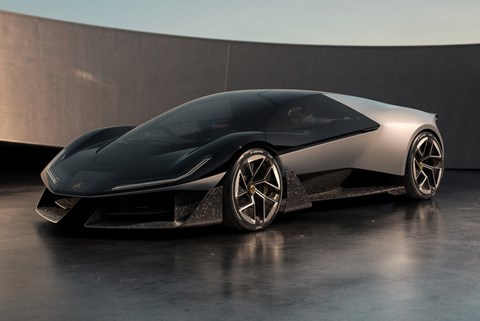
At the front, the Theory 1 uses something called laser wire from Kyocera in its headlight designs, where the brand’s modern light signature is incorporated using razor thin pieces of wire suspended and stretched taut. Using laser wire is like using fibre optics, but the entire wire glows with light rather than just the ends. Not needing loads of individual fibre optics, let alone much heavier and complex LED daytime running light formations, is good for weight saving without a loss of functionality.
The doors open upwards, but Lotus has decided to keep many of the door’s mechanisms exposed meaning large arms that were inset into the roof look as if they are lifting the doors up. It’s all very technical, but well integrated.
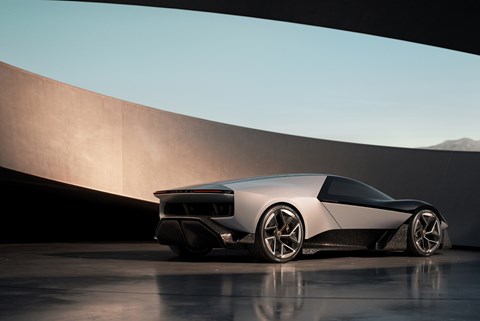
And that’s the overall vibe Payne and his team have been going for. He’s keen to showcase some of Lotus’ old strengths of lightness, the smart use of materials and the exposure of engineering. So much so that, if you look through the enormous opening underneath the rear wing/air brake integrated into tail, you’ll see the car’s pushrod suspension struts, axle beams and electric motor.
But, given it’s the 21st century and Lotus is a car company moving with the times, modern details include that digital light bar in the doors and a lidar sensors incorporated into the design. In fact, the lidar equipment at the front raises up ‘like pop-up headlights used to,’ smiles Payne.
Is it space-age inside?
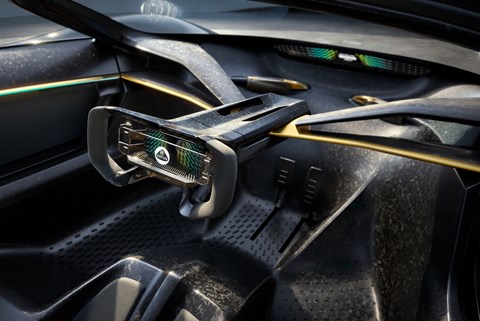
Very much, so. And what you’ll notice first is that it’s a three-seater; a driving position that Payne says is ‘as close as you can get to driving a Formula One car.
‘For a product designed for drivers, it instills and builds and inspires confidence. From a weight distribution point of view, you can’t get any better.’
You climb into a cockpit that’s surrounded by recycled chop carbonfibre, giving the lower ‘tub’ a sort of camouflage-like pattern. The seats are built into the tub, with thin pads and extremely intricate, 3D-printed headrests giving you plenty of comfort while keeping things as light as possible. Those headrests include individual speakers in them, which include active noise cancelling that allows each of the three occupants to be listening to individual media without the others hearing.
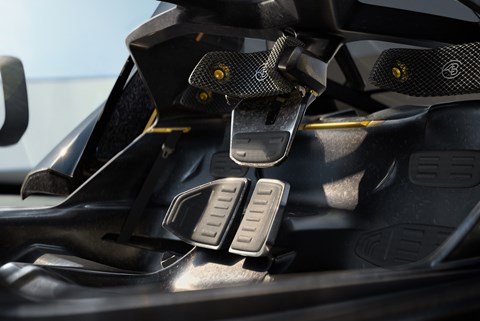
The seats are filled with small pads that inflate within a second from a brand called MotorSkins, giving them texture and grip. ‘We had this idea of including a lot of haptic communication,’ says Payne, ‘giving you something that’s very intuitive and gives you feedback to your driving situation without looking at a screen.’ So much so that Payne envisions driver assistance technologies being linked to the pads so you feel changes to the road around you rather than be shouted at by bongs or flashed at by distracting visual stimuli.
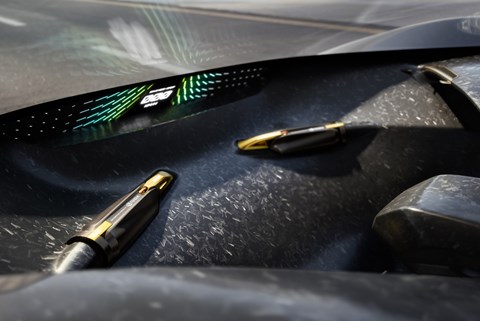
The steering wheel itself is bare bones and almost yoke-like in design. The grabhandles feature those haptic pads, too, and robust metallic paddles that feel wonderfully tactile in your hands. The car does have screens, but one is in-built into the lower edge of the windscreen – something you don’t notice until it turns on – and the only others are the glass displays for the digital camera mirrors.
So, if this thing was real… would it be fast?
Well, Lotus says this really is just a concept car. And yet there are some targeted performance figures ready for it, as the brand demonstrates how close a lot of the technology on board is to production readiness.
Theory 1, then, features a 70kWh battery pack, all-wheel drive electric power of circa-1000 metric horsepower (986bhp) and an estimated WLTP range of around 250 miles. Use of all those lightweight materials means Lotus is ‘targeting’ a weight figure of around 1600kg. Still heavy by Lotus’s sub-tonne Elise standards but, with a claimed 2.5-ish-second 0-62mph sprint time, it’s comparable to the Evija for performance.

On top of that, Lotus says there are five drive modes – Range, Tour, Sport, Individual and Track, like its production cars – and a 360-degree driver assistance suite that allows for Level 4 autonomous driving. Pirelli P Zero Elect tyres are fitted, as are next-generation AP Racing brakes.